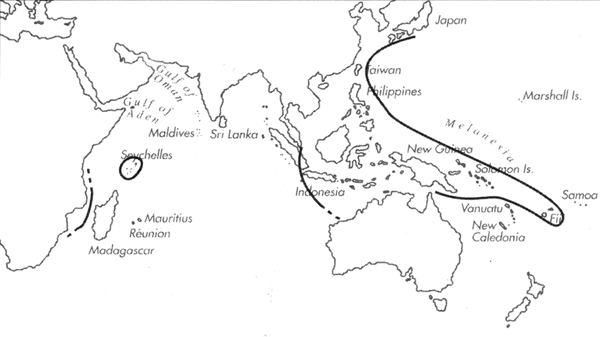Range: Mozambique, Mascarenes and Seychelles; Indonesia to Japan and to Fiji.
Description: Small to medium-sized, light to moderately solid. Last whorl conical to ventricosely conical, broadly conical in form ruppellii; outline variably convex adapically, slightly convex to almost straight below. Shoulder angulate to subangulate, smooth to weakly tuberculate. Spire of low to moderate height, variably concave in outline. Larval shell of about 2 whorls, maximum diameter 0.7-0.8 mm. Postnuclear spire whorls weakly tuberculate to nearly smooth. Teleoconch sutural ramps flat, with 1-2 increasing to 3-5 spiral grooves. Last whorl with weak or strong, mostly granulose ribs around basal fourth to half; sometimes granulose ribs to shoulder (form rivularis) (Pl. 6, Fig. 16).
| Shell Morphometry | ||
|---|---|---|
| L | 20-40 mm | |
| RW | 0.03-0.15 g/mm | |
| (L 20-33 mm) | ||
| RD | 0.61-0.72 | |
| (form ruppellii other forms 0.54 - 0.68) |
||
| PMD | 0.78-0.90 | |
| RSH | 0.09-0.18 | |
Ground colour white. Last whorl with large, irregularly shaped, yellowish to blackish brown markings above and below centre, often fusing into 2 spiral bands and sometimes coalescing axially. Spiral rows of fine brown to blackish brown dots extend from base to shoulder; dotted lines may be variably reduced or replaced by dashed lines. Base usually white ventrally. Larval shell and a variable number of adjacent sutural ramps light red or white. Later sutural ramps radially maculated with brown; usually same colour as last whorl; maculation variable. Sutural zone sometimes solid brown. Aperture white to light violet or pink. In form ruppellii (Pl. 6, Figs. 11-13), last whorl usually reddish to blackish brown except for narrow white spiral bands at centre and at shoulder, both crossed by brown axial markings. Spiral rows of larger brown dots and dashes than in other forms, from base to shoulder, often with intermittent white dots and dashes within dark areas. Larval shell white. Aperture white. Shells from Mozambique with bluish grey ground colour and olive- tan to dark olive spiral bands (Pl. 6, Figs. 9-10).
Periostracum olive to orange, thin, translucent to opaque, with fine axial and tufted spiral ridges (Cernohorsky, 1964; Chaberman, pers. comm., 1981).
At Hansa Bay (N. New Guinea), dorsum of foot cream to brown, with a dotted brown pre-marginal line ending anteriorly in a blotch on each side; lateral marginal zone and median zone dotted with brown. Sole of foot beige. Rostrum cream. Tentacles cream with white tips. Siphon tan to reddish brown, paler ventrally, with 2 weak brown rings back from the tip (Chaberman, pers. comm., 1981).
Habitat and Habits: Reported from lower reef slopes in Papua New Guinea and on sand and weed beneath coral in Fiji (Cernohorsky, 1964; Chaberman, pers. comm., 1981).
Discussion: For comparison to C. pauperculus and C. montillai, see the DISCUSSION of these species. The nominal species listed above in synonymy represent intraspecific variability of C. boeticus, as follows: - C. cerinus (Pl. 6, Fig. 17) is a form of C. boeticus with a relatively stout shell (RD 0.66-0.68), with few spiral rows of dots. - C. lachrymosus (Pl. 5, Fig. 18) is a form of C. boeticus with the shell largely overlaid with tan to reddish brown axial maculae and dashed to dotted spiral lines. - C. meleus, represented only by its holotype (Pl. 70, Figs. 1- 2), has a white shell with yellow axial blotches of both sides of centre; its morphological characters does not justify taxonomic separation from C. boeticus. Similar shells from Augustus Is., N.W. Australia (Pl. 70, Fig. 3) may be attached to this form. - C. nitidus (Pl. 5, Fig. 14) seems to be a juvenile specimen, described and depicted by Reeve as "light orange-brown . . and encircled . . with interrupted brown lines, apex . . pink". - C. rivularis refers (Pl. 6, Fig. 16) to entirely granulose shells of C. boeticus, known from Indonesia and the Philippines. - C. ruppellii (Pl. 6, Figs. 11-13) (syn. C. fultoni), known from Philippines and Indonesia, is assigned as a form of C. boeticus, because both occur sympatrically and the conchological differences do not justify separation at the species level. They can be separated neither by the characters of their larval shell nor by the morphometry and the sculpture of the teleoconch, and shells with an intermediate colour pattern occur.

C. boeticus Range Map
This section contains verbatim reproductions of the accounts of 316 species of Conus from the Indo-Pacific region, from Manual of the Living Conidae, by Röckel, Korn and Kohn (1995). They are reproduced with the kind permission of the present publisher, Conchbooks.
All plates and figures referred to in the text are also in Röckel, Korn & Kohn, 1995. Manual of the Living Conidae Vol. 1: Indo-Pacific Region.
The range maps have been modified so that each species account has it own map, rather than one map that showed the ranges of several species in the original work. This was necessary because each species account is on a separate page on the website and not confined to the order of accounts in the book.